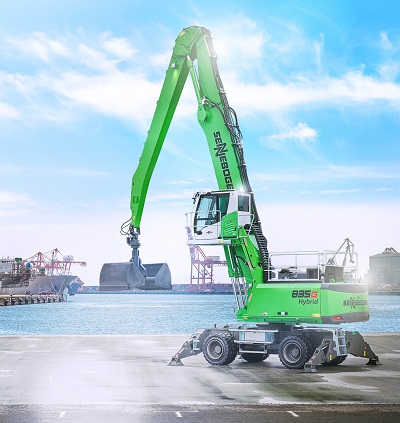Engineers at Sennebogen, Straubing, Germany, are embracing advanced diesel, hydraulic, electric and control technologies to design machines that generate significantly fewer emissions, compared to traditional equipment, and cut energy consumption in half. They’re building on proven and, in some cases, simple concepts that greatly benefit equipment users. Here’s a look at some of the innovations that are part of the company’s Green Efficiency program.

Energy recovery system
Sennebogen’s Green Hybrid system reportedly cuts energy consumption on equipment by as much as 30%. On a material-handling machine, for instance, hydraulically lifting the boom creates an opportunity for capturing potential energy that, in conventional units, converts to waste heat when the arm lowers and flow is metered to tank. In contrast, this hybrid system stores energy when lowering the boom and subsequently reuses that energy to raise the boom on the next lift. In turn, that reduces power demand from the engine and substantially cuts fuel consumption.
The boom on a conventional machine typically has two lift cylinders. The Green Energy system — essentially an independent hydraulic circuit — adds a third hydraulic cylinder on the boom connected to a bank of nitrogen-charged piston accumulators, plus the requisite valves to control flow. As the boom lowers, the cylinder retracts and forces pressurized fluid into the accumulators, which store energy by compressing gas. Initiating the next lift cycle releases the high-pressure fluid back to the cylinder to assist lifting, with minimal losses.
The main, pump-driven hydraulic circuit supplies the two outer cylinders, and the center Green Hybrid cylinder runs in tandem with the main machine hydraulics and augments the boom-up motion. Thus, all three cylinders supply power to lift the boom. Operation is transparent to the operator because the energy-saving circuit runs continuously.
Cylinder size and the number of accumulators depend on the type and size of machine. The system has been used for large Sennebogen material-handling equipment, but it was recently introduced on the smaller 835 G Hybrid material handler.
In this design, the two outer cylinders are part of the load-sensing hydraulics and provide the necessary force and precision control of movements. The Green Hybrid cylinder merely provides supplemental force to aid in lifting.
In addition to saving energy, it streamlines the overall design. Without the third “assist” cylinder, the size of the outer cylinders would increase. The hydraulics would require larger pumps. The engine would be larger and need a larger cooling system. There’s an entire cascade of benefits, thanks to the Green Hybrid system.
Efficient circuit design
As part of the Green Efficiency program, hydraulic valves and lines are sized for best efficiency. On the 835 G Hybrid, for instance, the hydraulics have been completely reworked, compared to previous models. Every hose, every connector diameter, every valve and all the flow cross-sections have been examined and optimized. All this has resulted in fine-tuning of the hydraulics through the sensible relief of pressure on the pump system.

The load-sensing /LUDV hydraulic system has a rated flow rate of 740 lpm (195 gpm) and operating pressure to 350 bar (5,076 psi). Optimized load-limit control ensures the best possible engine operating points at all times, even under full load. The control system includes proportional, precision hydraulic actuation of work movements, two hydraulic servo joysticks for work functions, and additional functions via switches and foot pedals. A thermostatically controlled fan drive operates on actual application requirements.
In addition, hydraulic circuits are safeguarded with safety valves and pipe-fracture valves, permitting emergency lowering in case of an unexpected engine shutdown. Efficient design contributes to extended oil service life, which enables significantly longer change intervals of 4,000 operating hours.
Balancer Equilibrium
In this simple and effective system, available on some Sennebogen equipment, a hydraulic cylinder moves a pivoting counterweight which assists lifting. On a tower- or gantry-mounted material handler, for example, the center of gravity (CG) is centrally located about the center of the slewing ring. In this system, when working with a load close to the center, a hydraulically driven coupling bar moves the counterweight towards the machine CG. When the boom and load extend away from the center, the counterweight is moved away from the CG.
The goal is to maintain constant moment loads, or equilibrium, between the boom and counterweight. The system works with just 50% of the installed motor and hydraulic drive power, compared to conventional machines, thanks to intelligent power distribution. According to the company, this is a simple and effective way to lower operating costs. It minimizes energy consumption, permits a smaller engine (or motor), and smaller hydraulic components.
EcoMode
EcoMode reduces specific fuel consumption on equipment by reducing engine speed from, for example, 2,000 rpm at full load to 1,200 rpm for around 20 sec at idle and then to 800 rpm. After five minutes, the engine automatically shuts off.
The idle mode cuts fuel consumption by up to 25% by lowering engine speed by 40%, and cuts NOx and soot emissions by up to 90%; when the engine switches off, there are no emissions or fuel consumption at all.
Electric drives
In operations that require limited mobility and grid power is readily available, modern electric-hydraulic drives can eliminate emissions and reduce operating costs by 50%. For example, the 835 G Hybrid material handler is powered by a 188 kW Cummins 6.7 l, Stage V diesel engine; or it can be fitted with an optional 160 kW electric drive.
Electric drives generally have low operating costs, thanks to lower energy costs, tend to extend the life of hydraulic components, have significantly longer maintenance intervals than with diesel engines, and have low maintenance costs, thanks to reduction in fuel and oil filters/oil changes.
Sennebogen
sennebogen-na.com
Filed Under: Mobile Hydraulic Tips, Trending